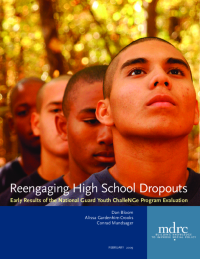Reengaging High School Dropouts
Early Results of the National Guard Youth ChalleNGe Program Evaluation
High school dropouts face daunting odds of success in a labor market that increasingly rewards education and skills. This report presents very early results from a rigorous, independent evaluation of the National Guard Youth ChalleNGe Program, an intensive residential program that aims to “reclaim the lives” of young people ages 16 to 18 who have dropped out of school. ChalleNGe currently operates in more than half the states. About 75,000 young people have completed the program since the early 1990s. MDRC, a nonprofit, nonpartisan research organization, is conducting the evaluation, along with the MacArthur Foundation’s Research Network on Transitions to Adulthood. Private foundations and the U.S. Department of Defense are funding the evaluation.
The 17-month ChalleNGe program is divided into three phases: Pre-ChalleNGe, which is a two-week orientation and assessment period; a 20-week Residential Phase built around eight core components designed to promote positive youth development; and a one-year Postresidential Phase featuring a structured mentoring program. During the first two phases, participants in the program live at the program site, often on a military base. The environment is described as “quasi-military,” though there are no requirements for military service.
The evaluation uses a random assignment research design. Because there were more qualified applicants than slots, a lottery-like process was used to decide which applicants were admitted to the program. The young people who were admitted (the program group) are being compared over time with those who were not admitted (the control group); any significant differences that emerge between the groups can be attributed to ChalleNGe. About 3,000 young people entered the study in 10 ChalleNGe programs in 2005-2006.
Early Results
About 80 percent of the program group started the program, two-thirds completed the Pre-ChalleNGe Phase, and about half graduated from the Residential Phase. A survey administered about nine months after the members of the program and control groups entered the study — not long after ChalleNGe graduates began the program’s Postresidential Phase — found that:
- The program group was much more likely than the control group to have obtained a high school diploma or a General Educational Development certificate (GED). At the time of the survey, 46 percent of the program group had a diploma or a GED, compared with about 10 percent of the control group.
- The program group was more likely than the control group to be working and attending college; members of the control group were more likely to have returned to high school. For example, just over 30 percent of the program group versus 21 percent of the control group reported that they were working full time.
- The program group reported better health and higher levels of self-efficacy and were less likely to have been arrested.
It is too early to draw any conclusions about the long-term effects of ChalleNGe. Nevertheless, the early results suggest that partway through their ChalleNGe experience, young people in the program group are better positioned to move forward in their transition to adulthood. Results from an 18-month survey will be available in late 2009.






